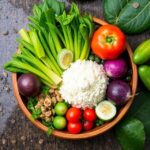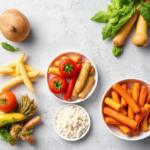Maha Shivratri, one of the most auspicious Hindu festivals, is celebrated with great devotion by millions of devotees worldwide. Dedicated to Lord Shiva, this festival involves fasting, night-long prayers, and offering sacred foods as prasadam. Devotees observe strict dietary guidelines while preparing food and consuming only sattvic (pure) ingredients.
In this comprehensive guide, we will explore:
- The significance of food during Maha Shivratri
- Traditional prasadam offered to Lord Shiva
- Fasting rules and allowed ingredients
- Delicious vrat-friendly recipes to try
Whether you are fasting or simply looking to prepare sacred offerings for Lord Shiva, this guide will help you make the most of Maha Shivratri with divine food and prasadam.
The Significance of Food During Maha Shivratri
Food plays an essential role in any Hindu festival, and Maha Shivratri is no exception. However, unlike other festivals where feasts are common, Maha Shivratri is primarily a fasting day. Devotees believe that abstaining from food purifies the mind and body, allowing them to focus on spiritual practices
Why Do People Fast on Maha Shivratri?
1. Spiritual Purification: Fasting detoxifies the body, increases self-discipline, and enhances spiritual focus.
2. Pleasing Lord Shiva: Devotees believe that fasting and offering food to Lord Shiva earn his blessings for health, prosperity, and liberation.
3. Symbolic Representation of the Universe: Maha Shivratri represents the cosmic dance of Lord Shiva, and fasting symbolizes detachment from worldly pleasures.
Though strict fasting is observed, certain foods are permitted, provided they are sattvic and free from onions, garlic, and grains
Traditional Maha Shivratri Prasadam Offerings
During Maha Shivratri, devotees offer various sacred foods to Lord Shiva before consuming them as prasadam. Here are some of the most common offerings:
1. Panchamrit (Sacred Nectar)
A divine mixture of five essential ingredients—milk, curd, honey, ghee, and sugar—Panchamrit is used for abhishekam (ritual bathing) of the Shiva Lingam and then distributed as prasadam.
Significance: Each ingredient symbolizes purity, nourishment, and devotion.
2. Bel Patra (Bilva Leaves) with Water and Milk
Devotees offer bilva leaves soaked in water or milk to the Shiva Lingam, as they are believed to be Lord Shiva’s favorite.
3. Fruits (Especially Bananas and Ber)
Fresh fruits like bananas, apples, and ber (Indian jujube) are offered as they are naturally sattvic and provide instant energy during fasting.
4. Dry Fruits and Nuts
Almonds, cashews, raisins, and dates are commonly offered and consumed during fasting as a rich source of energy.
5. Coconut and Coconut Water
Breaking a coconut symbolizes the destruction of the ego, and coconut water is offered as a sacred drink.
6. Sabudana Kheer (Tapioca Pudding)
Sabudana (sago) is widely used in vrat-friendly recipes, and sabudana kheer, made with milk and jaggery, is a delicious prasadam option.
7. Bael Sherbet (Wood Apple Juice)
Bael (wood apple) is a cooling fruit that is often made into a sherbet and offered to Lord Shiva.
Fasting Rules for Maha Shivratri
Since Maha Shivratri fasting is sacred, it follows certain dietary restrictions. Here’s what is allowed and what should be avoided:
Foods Allowed in Maha Shivratri Fast:
✔ Fruits like bananas, apples, papaya, and citrus fruits
✔ Dry fruits such as almonds, walnuts, and raisins
✔ Dairy products like milk, curd, paneer, and ghee
✔ Non-grain foods like sabudana (sago), kuttu (buckwheat), singhare ka atta (water chestnut flour), and rajgira (amaranth)
✔ Rock salt (sendha namak) instead of regular table salt
✔ Natural sweeteners like honey and jaggery
Foods to Avoid:
❌ Grains (wheat, rice, lentils, corn)
❌ Processed and fermented foods
❌ Onion and garlic (considered tamasic or impure)
❌ Spices like turmeric and mustard seeds
❌ Alcohol and non-vegetarian food
By following these fasting rules, devotees ensure their offerings and meals remain pure and sattvic.
Vrat-Friendly Maha Shivratri Recipes
1. Sabudana Khichdi (Tapioca Pearl Pilaf)
A light yet filling dish made with sabudana, peanuts, and mild spices.
Ingredients:
1 cup sabudana (soaked for 4-5 hours)
½ cup roasted peanuts (crushed)
1 boiled potato (chopped)
1 tsp cumin seeds
1-2 green chilies (finely chopped)
Rock salt to taste
1 tbsp ghee
Method:
1. Heat ghee in a pan, add cumin seeds and chilies.
2. Add boiled potatoes and stir for a minute.
3. Add soaked sabudana, rock salt, and peanuts.
4. Cook for 5-7 minutes on low flame. Serve hot.
2. Kuttu Ki Puri (Buckwheat Flour Puri)
A crispy, gluten-free puri perfect for fasting.
Ingredients:
1 cup kuttu atta (buckwheat flour)
1 boiled potato (mashed)
Rock salt to taste
Water as needed
Oil for frying
Method:
1. Mix kuttu atta, mashed potato, and rock salt.
2. Knead into a soft dough.
3. Roll into small puris and deep-fry in oil.
4. Serve with curd or aloo sabzi.
3. Lauki Halwa (Bottle Gourd Dessert)
A delicious and healthy vrat-special dessert.
Ingredients:
2 cups grated bottle gourd (lauki)
2 cups milk
½ cup jaggery
2 tbsp ghee
½ tsp cardamom powder
Chopped nuts for garnish
Method:
1. Heat ghee in a pan, add grated lauki, and sauté for 5 minutes.
2. Add milk and cook until absorbed.
3. Stir in jaggery and cardamom powder.
4. Cook until halwa thickens. Garnish with nuts.
Final Thoughts
Maha Shivratri is not just about fasting; it is about devotion, self-discipline, and connecting with Lord Shiva through sacred offerings. From Panchamrit and fruits to vrat-friendly dishes like sabudana khichdi and kuttu ki puri, each food item carries spiritual significance.
By preparing and consuming sattvic meals with devotion, devotees purify their bodies and minds, making the Maha Shivratri experience truly divine. May Lord Shiva bless you with happiness, health, and prosperity this Maha Shivratri!
Har Har Mahadev!
Related posts:
 How to Perform Maha Shivratri Puja at Home: Step-by-Step Guide
How to Perform Maha Shivratri Puja at Home: Step-by-Step Guide
 Astrological Significance of Maha Shivratri and Its Impact on Your Life
Astrological Significance of Maha Shivratri and Its Impact on Your Life
 Maha Shivratri 2025: Date, Time, and Significance
Maha Shivratri 2025: Date, Time, and Significance
 Best Foods for Rainy Season – Monsoon Diet Tips for a Healthy Life
Best Foods for Rainy Season – Monsoon Diet Tips for a Healthy Life
 Nutritional Benefits of Different Foods: A Guide to Healthy Eating
Nutritional Benefits of Different Foods: A Guide to Healthy Eating
 Maha Shivratri and Its Connection with Yoga and Meditation
Maha Shivratri and Its Connection with Yoga and Meditation
